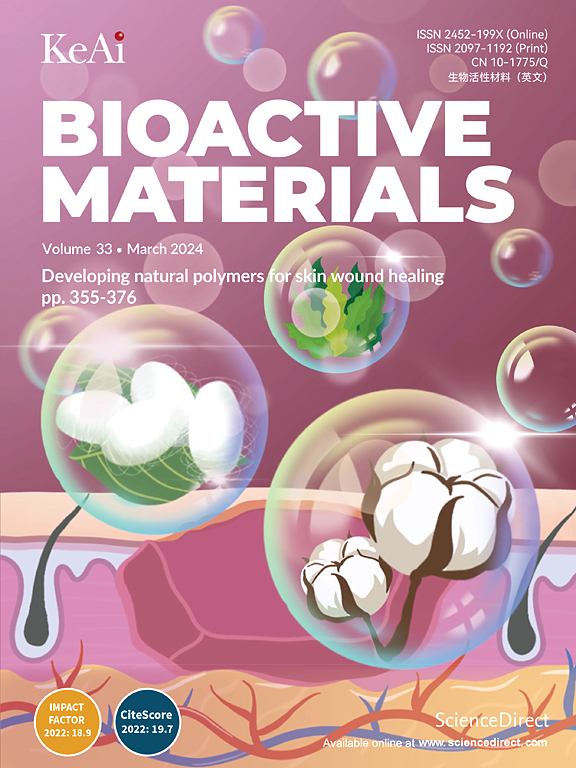Bioactive vascular buds promote collateral vessel formation by grafting on the artificial vessel walls
IF 18
1区 医学
Q1 ENGINEERING, BIOMEDICAL
引用次数: 0
Abstract
Vascular injury and some chronic ischemic lesions usually lead to insufficient blood supply to tissues, which will lead to tissue ischemia or even necrosis in severe cases. Current artificial blood vessels lack effective collateral vascularization capabilities to provide adequate blood supply in areas with restricted blood flow. Herein, inspired by the grafting of tree buds to form lateral branches, the vascular buds model was successfully constructed by inoculating HUVECs into bioactive hydrogel microspheres. Under the influence of ions dissolved from bioactive glass and three-dimensional culture environment, the cytoskeleton was remodeled, the cells showed obvious outward migration and budding trend, which significantly enhanced the angiogenesis ability. After grafted vascular buds to the lateral wall of the artificial blood vessel, a large number of collateral vessels are formed, which effectively alleviates the tissue ischemia in the region through which blood vessels pass. This study confirms the impact of bioactive ions on angiogenesis in a three-dimensional environment and offers novel insights for the development of lateral branches in artificial blood vessels.

生物活性血管芽通过嫁接在人造血管壁上促进侧支血管的形成
血管损伤和一些慢性缺血性病变通常会导致组织供血不足,严重时会导致组织缺血甚至坏死。目前的人工血管缺乏有效的侧支血管化能力,无法在血流受限的区域提供充足的血液供应。本研究以树芽嫁接形成侧枝为灵感,将HUVECs接种于生物活性水凝胶微球中,成功构建了血管芽模型。在生物活性玻璃溶解离子和三维培养环境的影响下,细胞骨架被重塑,细胞表现出明显的向外迁移和出芽趋势,血管生成能力明显增强。将血管芽移植到人工血管的外侧壁后,形成大量侧支血管,有效缓解了血管经过区域的组织缺血。本研究证实了生物活性离子在三维环境下对血管生成的影响,并为人工血管侧支的发育提供了新的见解。
本文章由计算机程序翻译,如有差异,请以英文原文为准。
求助全文
约1分钟内获得全文
求助全文
来源期刊

Bioactive Materials
Biochemistry, Genetics and Molecular Biology-Biotechnology
CiteScore
28.00
自引率
6.30%
发文量
436
审稿时长
20 days
期刊介绍:
Bioactive Materials is a peer-reviewed research publication that focuses on advancements in bioactive materials. The journal accepts research papers, reviews, and rapid communications in the field of next-generation biomaterials that interact with cells, tissues, and organs in various living organisms.
The primary goal of Bioactive Materials is to promote the science and engineering of biomaterials that exhibit adaptiveness to the biological environment. These materials are specifically designed to stimulate or direct appropriate cell and tissue responses or regulate interactions with microorganisms.
The journal covers a wide range of bioactive materials, including those that are engineered or designed in terms of their physical form (e.g. particulate, fiber), topology (e.g. porosity, surface roughness), or dimensions (ranging from macro to nano-scales). Contributions are sought from the following categories of bioactive materials:
Bioactive metals and alloys
Bioactive inorganics: ceramics, glasses, and carbon-based materials
Bioactive polymers and gels
Bioactive materials derived from natural sources
Bioactive composites
These materials find applications in human and veterinary medicine, such as implants, tissue engineering scaffolds, cell/drug/gene carriers, as well as imaging and sensing devices.
 求助内容:
求助内容: 应助结果提醒方式:
应助结果提醒方式:


